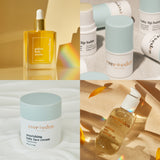For years, retinol has been praised for its effectiveness in treating everything from wrinkles to acne —but that doesn’t mean it works for everyone. It’s known to cause irritation in those with sensitive skin and it’s not safe for use during pregnancy. (The FDA lists retinol and its other vitamin A derivatives as category C drugs, which means “animal reproduction studies have shown adverse effects to a fetus and there are no well-controlled studies in humans.”) The good news? There’s a natural alternative that’s just as good.
Bakuchiol is derived from the leaves and seeds of the babchi plant (psoralea corylifolia). It’s been used in Ayurveda and Chinese medicine for both its anti-inflammatory and antibacterial benefits and studies over the last few years have shown it’s just as effective as retinol. Read on to learn more about our favorite plant-powered retinol alternative.
The benefits
Just like retinol, bakuchiol is used to address wrinkles, hyperpigmentation, and acne—and it performs just as well. This powerful plant helps speed up collagen production and increases cell turnover, which gives skin a healing boost from within. Dermatologists say it's gentle enough to be used by those with sensitive skin or with conditions like eczema. There’s also no need to worry about sun sensitivity like you would with retinol, which means you can use it twice a day. (And yes, you still need to wear sunscreen!)
Bakuchiol vs Retinol
A study from 2018 showed that bakuchiol was just as effective as retinol when used for photoaging (aka sun damage). Both ingredients “significantly decreased wrinkle surface area and hyperpigmentation” and bakuchiol was shown to be “comparable with retinol in its ability to improve photoaging and is better tolerated.”
Another study from 2014 comparing bakuchiol to retinol showed that after 12 weeks, there was “significant improvement in lines and wrinkles, pigmentation, skin elasticity and firmness and an overall reduction in photo-damage.” The study's authors concluded that bakuchiol was just as effective for anti-aging as retinol. Pretty cool, right?
Bakuchiol during pregnancy
Just when you thought bakuchiol couldn’t get any better, there’s the fact that it’s safe to use during pregnancy and breastfeeding. Which means you can use it to amp up that pregnancy glow or deal with those pesky breakouts. Of course, always consult with your doctor or dermatologist before adding a new product to your routine.
How to use it
Bakuchiol has become a popular ingredient in facial skincare over the years, found in everything from serums to moisturizers. Because bakuchiol is gentle, it’s easy to pair with other actives and antioxidants, like vitamin C.
We figured if it’s good enough for your face, it’s good enough for your body, which is why we added it to our new Golden Body Serum. This all-over body oil pairs bakuchiol with vitamin C, red tourmaline extract (a natural crystal extract), and microalgae to brighten, smooth, and visibly tone skin. Golden Body Serum is clinically proven to boost radiance, immediately hydrate & strengthen skin barrier*. Get glowing with the help of your new favorite ingredient.
*Based on a 2-week clinical study with 27 women aged 23-68









